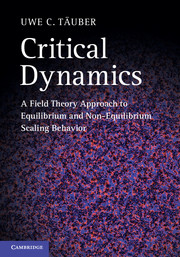Book contents
- Frontmatter
- Dedication
- Contents
- Preface
- Part I Near-equilibrium critical dynamics
- Part II Scale invariance in non-equilibrium systems
- 8 Non-equilibrium critical dynamics
- 9 Reaction-diffusion systems
- 10 Active to absorbing state transitions
- 11 Driven diffusive systems and growing interfaces
- Index
- References
9 - Reaction-diffusion systems
from Part II - Scale invariance in non-equilibrium systems
Published online by Cambridge University Press: 05 June 2014
- Frontmatter
- Dedication
- Contents
- Preface
- Part I Near-equilibrium critical dynamics
- Part II Scale invariance in non-equilibrium systems
- 8 Non-equilibrium critical dynamics
- 9 Reaction-diffusion systems
- 10 Active to absorbing state transitions
- 11 Driven diffusive systems and growing interfaces
- Index
- References
Summary
This chapter addresses the stochastic dynamics of interacting particle systems, specifically reaction-diffusion models that, for example, capture chemical reactions in a gel such that convective transport is inhibited. Generic reaction-diffusion models are in fact utilized to describe a multitude of phenomena in various disciplines, ranging from population dynamics in ecology, competition of bacterial colonies in microbiology, dynamics of magnetic monopoles in the early Universe in cosmology, equity trading on the stock market in economy, opinion exchange in sociology, etc. More concrete physical applications systems encompass excitons kinetics in organic semconductors, domain wall interactions in magnets, and interface dynamics in growth models. Yet most of our current knowledge in this area stems from extensive computer simulations, and actual experimental realizations allowing accurate quantitative analysis are still deplorably rare. We begin with a brief review of mean-field and scaling arguments including Smoluchowski's self-consistent treatment of diffusion-limited binary annihilation. The main goal of this chapter is to demonstrate how one may systematically proceed from a microscopic master equation for interacting particles, which perhaps represents the most straightforward description of a system far from equilibrium, to a non-Hermitean bosonic ‘quantum’ many-body Hamiltonian, and thence to a continuum field theory representation that permits subsequent perturbative expansions and renormalization group treatment. The ensuing rich physics is illustrated with simple examples that include the annihilation reactions k A → l A (l < k) and A + B ∅, their generalization to multiple particle species, as well as reversible recombination A + A ⇌ B.
- Type
- Chapter
- Information
- Critical DynamicsA Field Theory Approach to Equilibrium and Non-Equilibrium Scaling Behavior, pp. 345 - 399Publisher: Cambridge University PressPrint publication year: 2014

